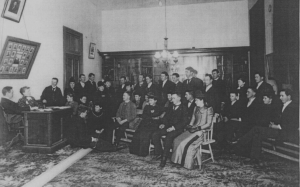Campus societies are a large portion of any university history, older universities such as Harvard or Yale pride themselves on their societies. The men and women who have participated in literary societies historically have found lucrative jobs and connections due to the unique experience that these societies provide to undergraduates. Literary societies were regularly founded in pairs in order to foster competition and growth. This history often brings to mind older institutions on the east coast. However, the University of Oregon is no stranger to the benefits of literary societies on its campus.
The earliest known literary societies at the University of Oregon are the Laurean and Eutaxian societies, founded in 1876 and 1877. These two prominent organizations provided early UO students with a social outlet as well as an academic one. The men’s society, the Laurean was founded first, very closely followed by the women’s, the Eutaxian. As the societies grew in number, coming to encompass forty percent of the male population and twenty percent of the female population, the university had to find space for them. Deady hall being the only available location the school promised continuously to tear down a wall in between two classrooms. Fortunately for the societies, in 1882, members managed to “accidentally”put a hole in the dividing wall, forcing the university to create one large meeting space for them.
One would think that men’s and women’s societies would hardly interact, existing in their own circles and debating separately. Contrary to this belief these societies repeatedly came together to debate the same topics ranging from African American suffrage, the size of women’s brains in comparison to a man’s, and even hypnotism. All topics garnering the same levels of animated debate and exuberant support or opposition. These debates were the main show, creating a space where students could question and argue beliefs safely. The outcome of debates usually being the last thing on everyone’s minds as the debates were the most important part. Students would argue their points back and forth, often using body language to support or emphasize their points. The audience would participate simply through the wave of a handkerchief, as they were simply there to learn and observe the debates.
These two societies were also instrumental in creating the university’s first student publication, called The Reflector.
Published from 1891 to 1894, the weekly newspaper published updates that covered anything from campus construction news to local and class reports. It even published society updates and minutes. The Reflector was kept entirely anonymous except for the editorial staff as a way to not only grant students freedom to speak but to keep them accountable and honest. The Reflector is a way to look back and understand what some of these students were dealing with in the late 19th century. Their topics still carry relevant themes people are questioning today, for example, an article in their second volume identifies the topic of immigration. The author grapples with the concept of a nation built on immigration and how it was immigration that made this country great and influential. However, they also touch on what happens now that America has become an actual nation, and how immigration will affect the future. Even though times have changed these students were identifying and asking questions that carried global implications that still hold over today.
Meghan Kerr
Student Research Assistant
_____________________________
References:
The Reflector https://scholarsbank.uoregon.edu/xmlui/handle/1794/13187
The Early Days of the University of Oregon by Inez Long Fortt
Pioneers Scholars & Rogues by Jeffery Jane Flowers
See also, “The Fourth Estate: A History of the Earliest Student Publications at the University of Oregon,” by Zach Bigalke




